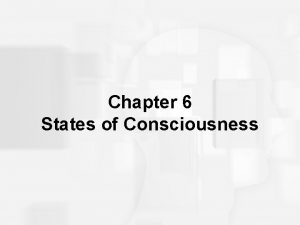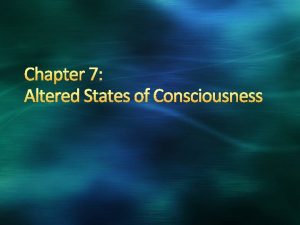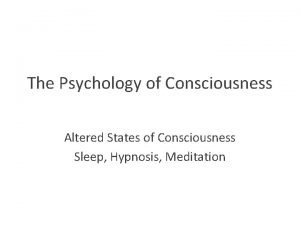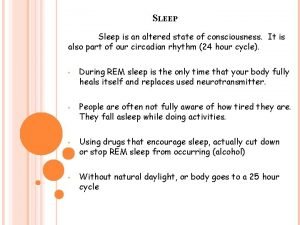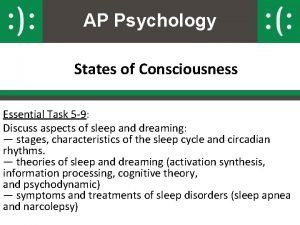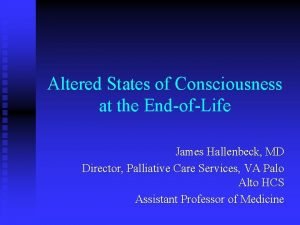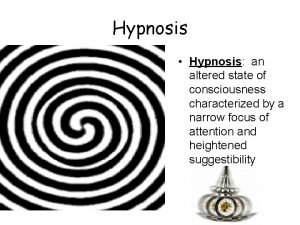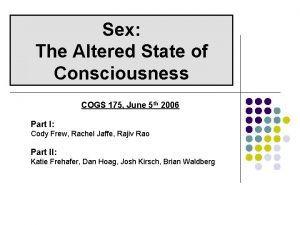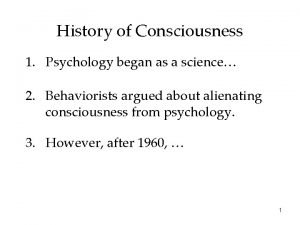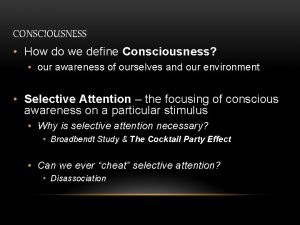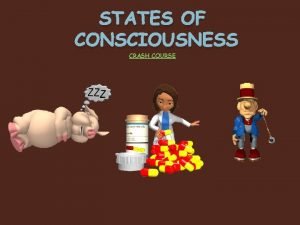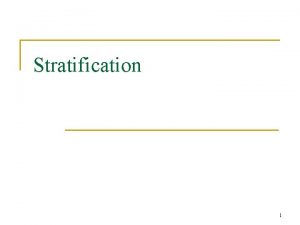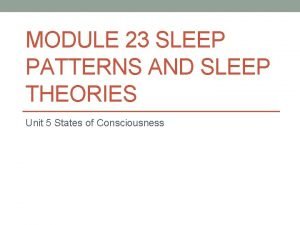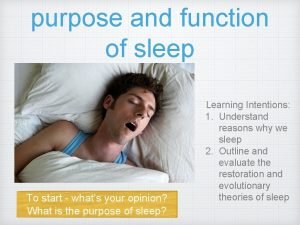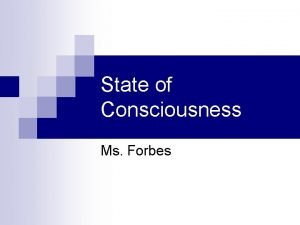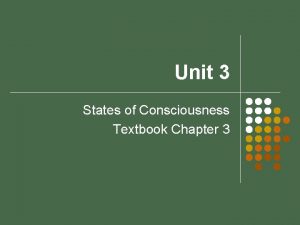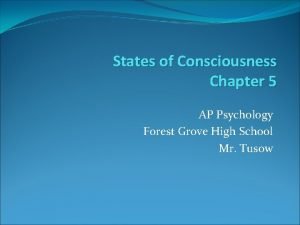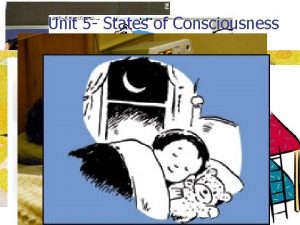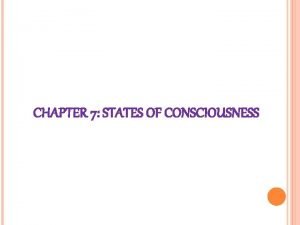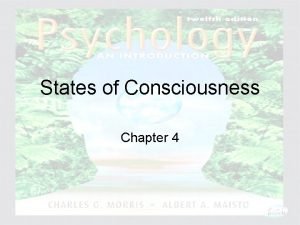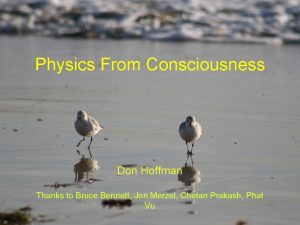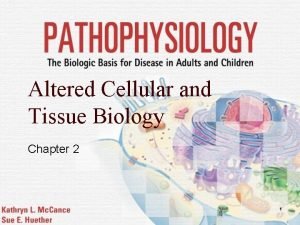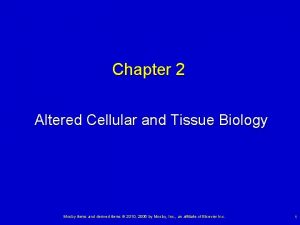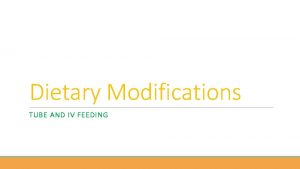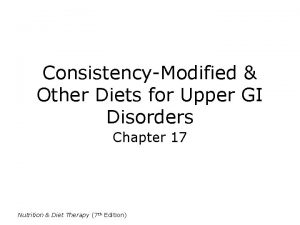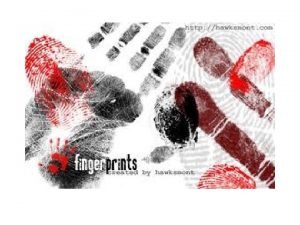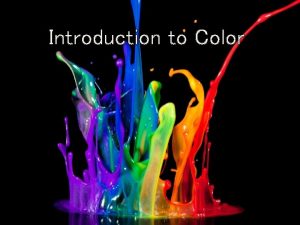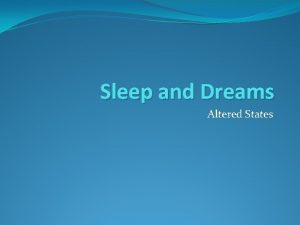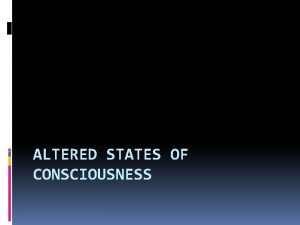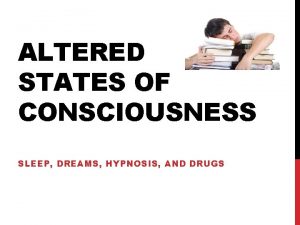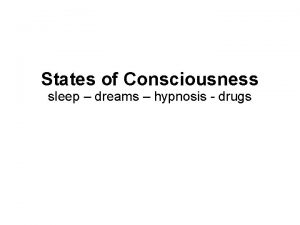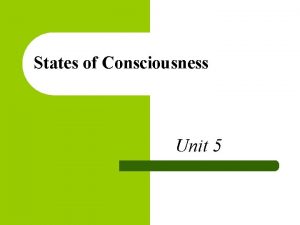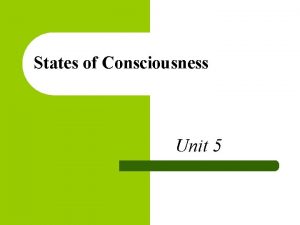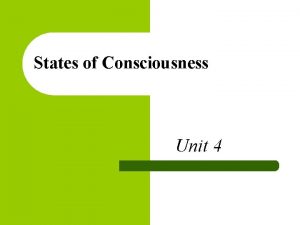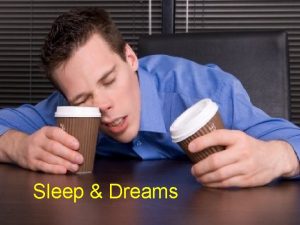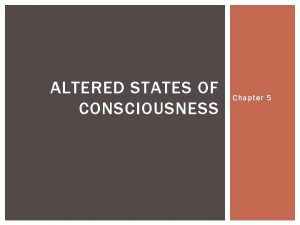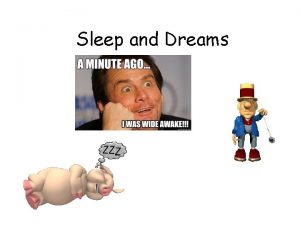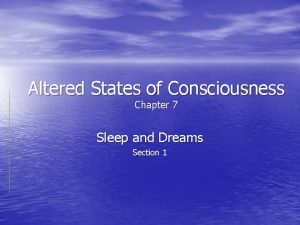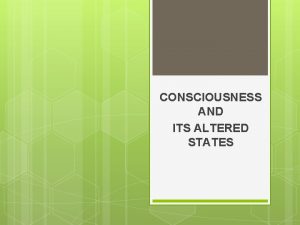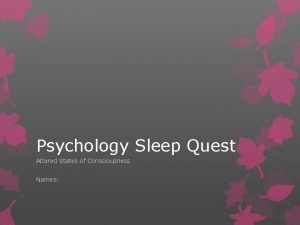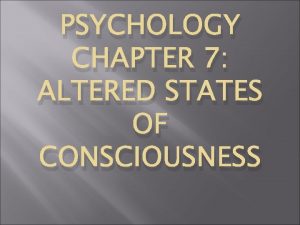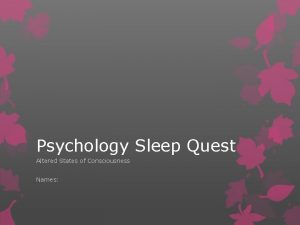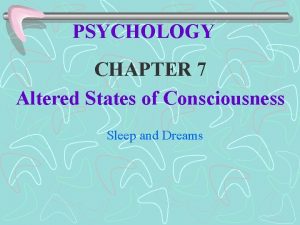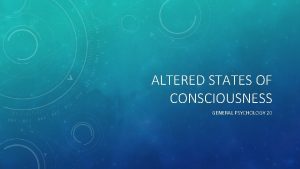Altered States of Consciousness Sleep and Dreams Consciousness





































- Slides: 37

Altered States of Consciousness

Sleep and Dreams � Consciousness: a state of awareness, including a person’s feelings, sensations, ideas, and perceptions


Why do we sleep? � Beliefs: ◦ Restorative – it allows people to “charge their batteries” ◦ A time when the brain recovers from exhaustion and stress ◦ Type of primitive hibernation to conserve energy ◦ To clear our minds of useless information ◦ To dream

Stages of Sleep � Early stages: ◦ Stages 1 -3: pulse slows; muscles relax; breathing becomes uneven and brain waves grow irregular; eyes roll slowly from side to side (30 minutes)

Stages of Sleep � Later stages: ◦ Stage 4 is the deepest sleep; if awakened by a loud noise or sudden movement, may feel disoriented; talking out loud, sleepwalking, and bed-wetting leave no trace on the memory; on average a persons spends 75% of sleep time in stages 1 -4

Stages of Sleep ◦ Stage 5: muscles are even more relaxed, eyes begin to move more rapidly �REM: rapid eye movement: a stage of sleep characterized by rapid eye movements, a high level of brain activity, a deep relaxation of the muscles, and dreaming; lasts from 15 -45 minutes – then return to stage 4 go through this cycle approximately every 90 minutes

How much sleep? � Humans spend approximately 1/3 of their lives in sleep � Newborns spend about 16 hours a day sleeping � 16 year olds spend 10 -11 hours � Graduate students spend 8 hours � 70 year olds may only need 5 hours � People have an internal biological clock that regulates the sleep-wakefulness cycle ◦ Circadian rhythm: the rhythm of activity and inactivity lasting approximately one day

Sleep Disorders � Insomnia: the failure to get enough sleep at night in order to feel rested the next day (usually caused by mental stress) � Sleep apnea: a sleep disorder in which a person has trouble breathing while sleeping (usually caused by a physical problem)

Sleep Disorders � Narcolepsy: a condition characterized by suddenly falling asleep or feeling very sleepy during the day � Nightmares: unpleasant dreams � Night terrors: sleep disruptions that occur during stage 4 of sleep, involving screaming, panic, or confusion � Sleepwalking: walking or carrying out behaviors while asleep

DREAMS � Content of dreams: ◦ often we incorporate everyday activities into our dreams ◦ a large percentage of the emotions experienced in dreams are negative or unpleasant – anxiety, anger, sadness, etc. ◦ Dreams do not occur in a split second – they correspond to a realistic time scale ◦ Some dreams are negative enough to be considered nightmares – nightmares have a frightening quality that we awaken in the middle of them �The sense of dread in nightmares may be related to the intensity of brain activity and to the stimulation of those parts of the brain responsible for emotional reactions

Lucid Dreaming � 1. Knowing that you are dreaming � 2. Being able to control your own dream actions in a wake-like fashion � 3. Being able to manipulate your dream surroundings � 4. Being able to manipulate the dream actions of other people in your dreams � Lucid dreamers use their conscious control center in the prefrontal cortex while the rest of the brain is in a dream-like state. In other words, in a lucid dream, your brain's control center is awake while the rest of the brain is asleep.

Sleep Paralysis � Simply a sign that your body is not moving smoothly through the stages of sleep � Rarely is sleep paralysis linked to deep underlying psychiatric problems � A feeling of being conscious but unable to move � Occurs when a person passes between stages of wakefulness and sleep (usually when a person is falling asleep or waking up) � During these transitions, you may be unable to move or speak for a few seconds up to a few minutes. Some people may also feel pressure or a sense of choking.

� “Big dreams [vivid and memorable, transformative dreams you remember for the rest of your life] are once again on the minds of psychologists as part of a larger trend toward studying dreams as meaningful representations of our concerns and emotions. ” � What does this quote mean to you? What is the importance of dreams? What meaning, if any, do you attach to dreams?

Dream Interpretation � Freud believed that dreams may contain clues to thoughts the dreamer is afraid to acknowledge in his or her waking hours � The Inuit people of North America believe that dreams contain hidden meanings – they believe that when dreaming, people enter the spiritual world where they interact with those who have passed away – those departed souls help the living reflect on some current or future event

Dream Interpretation � Some social scientists believe that dreams may serve no function whatsoever – the experience of a dream is simply an unimportant by-product of stimulating certain brain cells during sleep � Others argue that the common experience of feeling paralyzed in a dream means that brain cells that inhibit muscle activity were randomly stimulated

Dream Interpretation � One theory proposes that dreaming allows people a chance to review and address some of the problems they faced during the day � Another theory is that dreams are the brain’s way of removing certain unneeded memories – dreams are a form of mental housecleaning

Daydreaming � Daydreaming requires a low level of awareness and involves fantasizing or idle but directed thinking, while we are awake � Daydreaming reminds us of or prepares us for events in our future � Daydreaming may improve our creativity by generating thought processes � Some psychologists believe that daydreaming allows us to control our emotions

Therapy � How can dreams be used as a healing tool in therapy? ◦ Depression ◦ Trauma

Hypnosis, Biofeedback, and Meditation � Hypnosis: a state of consciousness resulting from a narrowed focus of attention and characterized by heightened suggestibility � https: //www. youtube. com/watch? v=9 PW 1 fw. K jo-Y

Hypnosis � Psychologists do not agree about the nature of hypnosis – some argue that hypnosis is not a special state of consciousness but simply the result of suggestibility ◦ If people are given instructions and told to try their hardest, they will be able to do anything that hypnotized people can do

Hypnosis � Others, like Ernest Hilgard, believe that people who are hypnotized are very suggestible – they go along with the hypnotist and do not initiate activities themselves – they can more easily imagine and remember things � Hilgard believes that consciousness includes many different aspects that become separated, or dissociated, during hypnosis (neodissociation theory) ◦ Includes a “hidden observer” a portion of the personality that watches and reports what happens to the hypnotized person

Hypnosis � Another belief is the hypnotized people behave as they do because they have accepted the role of a hypnotized subject – we expect that hypnotized individuals will forget certain things when told or will recall forgotten material, and we play the role

Use of Hypnosis � Posthypnotic suggestion: a suggestion made during the hypnosis that influences the participant’s behavior afterward – can be helpful in changing unwanted behaviors, such as smoking or overeating ◦ Ex. The hypnotist can suppress memory by suggesting that after the person is awakened, she will be unable to hear the word psychology – when she is out of the trance, she may report that some people around her are speaking strangely and the people seem to leave out words �The participant is not aware that part of her consciousness has been instructed to block out that word

Hypnotic Analgesia �A reduction of pain reported by patients after they had undergone hypnosis ◦ The hypnotist works with the patient to reduce his or her anxiety and encourage relaxation therefore, a person’s perception of pain is reduced

Hypnosis and Therapy � Therapists use hypnosis to help clients reveal their problems or gain insight into their lives � Hypnotherapists use hypnosis to allow their patients to think of their problems in a new way � Some patients fear the loss of control associated with hypnosis

Biofeedback � The process of learning to control bodily states with the help of machines monitoring the states to be controlled (feedback makes learning possible) ◦ Ex. You could be hooked up to a biofeedback machine so that a light goes on every time your heart rate goes over 80 – you can then learn to keep your heart rate below 80 by trying to keep the light off

Biofeedback � Biofeedback has been used to teach people to control a wide variety of physiological responses – including brain waves, heart rate, blood pressure, skin temperature, and sweat-gland activity � Biofeedback uses machines to tell people about very subtle, moment to moment changes in the body – people can then experiment with different thoughts and feelings while they watch how each affects their bodies – in time, people can learn to change their physiological processes

Meditation � The focusing of attention to clear one’s mind and produce relaxation � Transcendental meditation: the mental repetition of a mantra – the participant sits with eyes closed and meditates for 15 to 20 minutes twice a day � Mindfulness meditation: developed from a Buddhist tradition; focuses on the present moment – the person may move his or her focus through the body from the tips of the toes to the top of the head, while paying attention to the areas that cause pain � Breath meditation: a concentration of one’s respiration – the process of inhaling and exhaling

Drugs and Consciousness � Psychoactive drugs: chemicals that affect the nervous system and result in altered consciousness – they interact with a person’s central nervous system to alter a person’s mood, perception, and behavior

Psychoactive Drugs � Depressant � Tranquilizer � Opiates � Stimulants Alcohol Valium, Xanax Morphine, Heroin caffeine, amphetamines, cocaine stimulant-depressants Nicotine � Distortion of Experience Marijuana � Hallucinogens LSD � Mixed

How Drugs Work � Drugs are carried by the blood and taken up in target tissues in various parts of the body � People introduce drugs into their systems through routes that bring the drugs into contact with capillaries (the smallest blood vessels) � From there, drugs are gradually absorbed into the blood � Then drug molecules act like neurotransmitters and hook onto the ends of nerve cells (neurons) and send out their own chemical messages

Marijuana � The dried leaves and flowers of Indian hemp (Cannabis sativa) that produce an altered state of consciousness when smoked or ingested � The active ingredient in marijuana is tetrahydrocannabinol (THC)

Hallucinations � Perceptions that have no direct external cause – seeing, hearing, smelling, tasting, or feeling things that don’t exist � Can be caused by hypnosis, meditation, certain drugs, withdrawal from certain drugs after an addiction, and psychological breakdown � Can also occur when people are dreaming or are deprived of sleep, as well as period of high emotion, concentration, or fatigue

Hallucinogens � Drugs that often produce hallucinations (also called psychedelics) – they can create a false body image and cause loss of self, dreamlike fantasies, and hallucinations ◦ LSD: (lysergic acid diethylamide) the most wellknow, most extensively studied, and most potent hallucinogen

Opiates � Produce pain reduction, euphoria (a pleasurable state between awake and sleep), and constipation ◦ An overdose results in loss of control of breathing – the user then dies from respiratory failure

Drug Abuse and Treatment � 1. The drug abuser must admit that he or she has a problem. � 2. The drug abuser must enter a treatment program and/or get therapy. � 3. The drug abuser must remain drug free. Many drug addicts are encouraged to join support groups to help them reduce drug use and fight off the temptation of returning to drugs. Many drug addicts suffer a relapse; that is, they return to using drugs. Support groups can be a powerful force in preventing that occurrence.
 Lesson quiz 7-1 altered states of consciousness
Lesson quiz 7-1 altered states of consciousness Circadian rhythm def
Circadian rhythm def Chapter 7 altered states of consciousness
Chapter 7 altered states of consciousness Altered state of consciousness psychology
Altered state of consciousness psychology An altered state of consciousness
An altered state of consciousness Sleep theories ap psychology
Sleep theories ap psychology Altered state of consciousness psychology
Altered state of consciousness psychology Altered state of consciousness psychology
Altered state of consciousness psychology Is hypnosis an altered state of consciousness
Is hypnosis an altered state of consciousness Sex altered state of consciousness
Sex altered state of consciousness Dreams consciousness
Dreams consciousness Dreams consciousness
Dreams consciousness Consciousness crash course
Consciousness crash course Altered states game
Altered states game Type of social mobility
Type of social mobility Module 23 sleep patterns and sleep theories
Module 23 sleep patterns and sleep theories Module 23 sleep patterns and sleep theories
Module 23 sleep patterns and sleep theories Module 23 sleep patterns and sleep theories
Module 23 sleep patterns and sleep theories Thou blind man's mark summary
Thou blind man's mark summary Adults spend about ______% of their sleep in rem sleep.
Adults spend about ______% of their sleep in rem sleep. 3 states of consciousness
3 states of consciousness Alpha waves ap psychology
Alpha waves ap psychology 7: states of consciousness psychology
7: states of consciousness psychology Unit 5 states of consciousness answers
Unit 5 states of consciousness answers Chapter 7 states of consciousness
Chapter 7 states of consciousness Ap psychology states of consciousness
Ap psychology states of consciousness Unit 5 states of consciousness
Unit 5 states of consciousness Altered cellular and tissue biology
Altered cellular and tissue biology Altered cellular and tissue biology
Altered cellular and tissue biology What were the 11 free states
What were the 11 free states Map of northern united states
Map of northern united states Big states vs small states guard against tyranny
Big states vs small states guard against tyranny Mechanically altered diet
Mechanically altered diet Mechanically altered diet
Mechanically altered diet Altered cognition in older adults is commonly attributed to
Altered cognition in older adults is commonly attributed to Wax spacer
Wax spacer Can fingerprints be altered or disguised how
Can fingerprints be altered or disguised how 120706color
120706color
